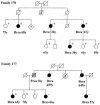A CHEK2 genetic variant contributing to a substantial fraction of familial breast cancer
- PMID: 12094328
- PMCID: PMC379177
- DOI: 10.1086/341943
A CHEK2 genetic variant contributing to a substantial fraction of familial breast cancer
Abstract
CHEK2 (previously known as "CHK2") is a cell-cycle-checkpoint kinase that phosphorylates p53 and BRCA1 in response to DNA damage. A protein-truncating mutation, 1100delC in exon 10, which abolishes the kinase function of CHEK2, has been found in families with Li-Fraumeni syndrome (LFS) and in those with a cancer phenotype that is suggestive of LFS, including breast cancer. In the present study, we found that the frequency of 1100delC was 2.0% among an unselected population-based cohort of 1,035 patients with breast cancer. This was slightly, but not significantly (P=.182), higher than the 1.4% frequency found among 1,885 population control subjects. However, a significantly elevated frequency was found among those 358 patients with a positive family history (11/358 [3.1%]; odds ratio [OR] 2.27; 95% confidence interval [CI] 1.11-4.63; P=.021, compared with population controls). Furthermore, patients with bilateral breast cancer were sixfold more likely to be 1100delC carriers than were patients with unilateral cancer (95% CI 1.87-20.32; P=.007). Analysis of the 1100delC variant in an independent set of 507 patients with familial breast cancer with no BRCA1 and BRCA2 mutations confirmed a significantly elevated frequency of 1100delC (28/507 [5.5%]; OR 4.2; 95% CI 2.4-7.2; P=.0002), compared with controls, with a high frequency also seen in patients with only a single affected first-degree relative (18/291 [6.2%]). Finally, tissue microarray analysis indicated that breast tumors from patients with 1100delC mutations show reduced CHEK2 immunostaining. The results suggest that CHEK2 acts as a low-penetrance tumor-suppressor gene in breast cancer and that it makes a significant contribution to familial clustering of breast cancer-including families with only two affected relatives, which are more common than families that include larger numbers of affected women.
Figures


References
Electronic-Database Information
-
- Online Mendelian Inheritance in Man (OMIM), http://www.ncbi.nlm.nih.gov/Omim/ (for BRCA1 [MIM 113705], BRCA2 [MIM 600185], CHEK2 [MIM 604373], and LFS [MIM 151623])
References
-
- Antoniou AC, Pharoah PD, McMullan G, Day NE, Ponder BA, Easton DF (2001) Evidence for further breast cancer susceptibility genes in addition to BRCA1 and BRCA2 in a population-based study. Genet Epidemiol 21:1–18 - PubMed
-
- Bartek J, Falck J, Lukas J (2001) CHK2 kinase: a busy messenger. Nat Rev Mol Cell Biol 2:877–886 - PubMed
-
- Bartkova J, Falck J, Rajpert-De Meyts E, Skakkebaek NE, Lukas J, Bartek J (2001) Chk2 tumour suppressor protein in human spermatogenesis and testicular germ-cell tumours. Oncogene 20:5897–5902 - PubMed
-
- Bell DW, Varley JM, Szydlo TE, Kang DH, Wahrer DC, Shannon KE, Lubratovich M, Verselis SJ, Isselbacher KJ, Fraumeni JF, Birch JM, Li FP, Garber JE, Haber DA (1999) Heterozygous germ line hCHK2 mutations in Li-Fraumeni syndrome. Science 286:2528–2531 - PubMed
Publication types
MeSH terms
Substances
Associated data
- Actions
- Actions
- Actions
- Actions
LinkOut - more resources
Full Text Sources
Other Literature Sources
Medical
Molecular Biology Databases
Research Materials
Miscellaneous

